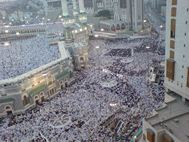 Artificial intelligence safety cameras – which detect dangerous levels of crowding with one hundred per cent accuracy during day or night – have been developed by a Nottingham Trent University academic. The smart camera system, designed by a research team lead by Dr Amin Al-Habaibeh of the School of Architecture, Design and the Built Environment, is intended to help save lives by improving crowd safety at large open space public gatherings.
Artificial intelligence safety cameras – which detect dangerous levels of crowding with one hundred per cent accuracy during day or night – have been developed by a Nottingham Trent University academic. The smart camera system, designed by a research team lead by Dr Amin Al-Habaibeh of the School of Architecture, Design and the Built Environment, is intended to help save lives by improving crowd safety at large open space public gatherings.
The technology, which combines an infrared camera and a monochrome visual camera, can measure the real time density of crowds and signals when and where hazardous levels of overcrowding occur in various spots. The technology can also give a strong estimation of crowd numbers.
Tests showed that by combining the two types of cameras, and by linking them up to a computer with temperature and light sensors, the margin of error for detecting different crowd densities was zero per cent when using the artificial intelligent system.
“Large scale public events still present huge safety risks and there are several recent examples of incidents which have resulted in loss of life,” said Dr Al-Habaibeh, who carried out the research in conjunction with the Um Al-Qura University in Mecca, Saudi Arabia.
“It’s important that technology helps minimise those risks and, where possible, helps prevent any instances such as crushing. The project has many potential applications around the world including sport events and city festivals.
“This invention is a step forward as it will provide real time data during day or night, in fog or smoke, about how dense a crowd is in an open space. It will enable those in charge of safety to take swift action before any sort of incident occurs.”
The technology centres on the monochrome visual camera detecting the outline of individuals in the crowd, while the infrared camera senses heat is emitted from their bodies.
The artificial intelligence system calibrates the side-effects of sunlight and of people in the foreground appearing larger to the camera than those in the background.
When a density of five persons or more per metre² occurs – which is considered to be extremely high – an alert signal can be activated.
Saied Yaseen, Nottingham Trent University’s postgraduate researcher on the project, added: “The ability of the system to operate in the dark or smoke makes it particularly useful for emergency situations.
“It will give security staff the knowledge of whether or not people’s safety is at risk, even when this is impossible tell with the naked eye.”
 CIE Components in Electronics
CIE Components in Electronics
